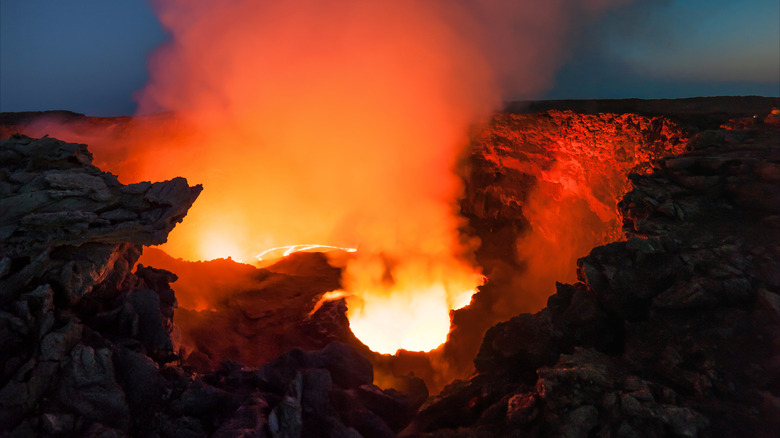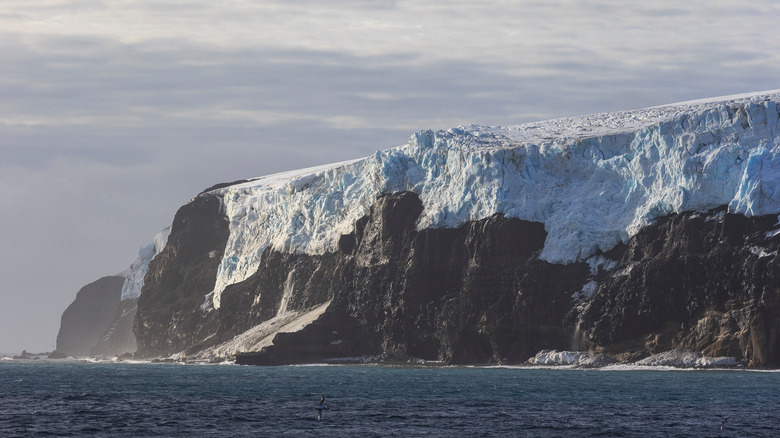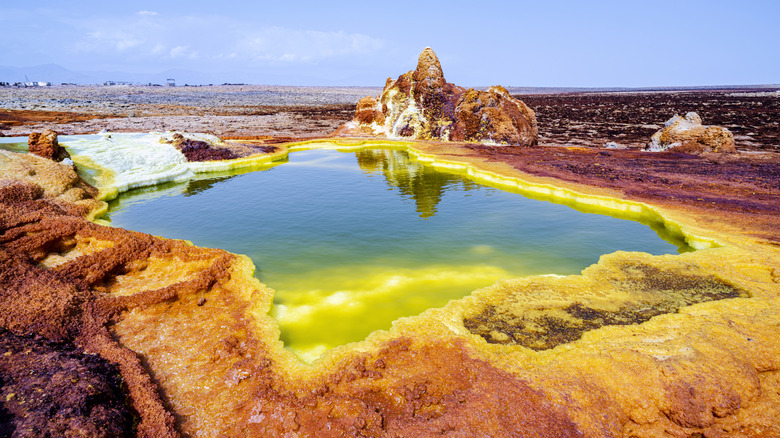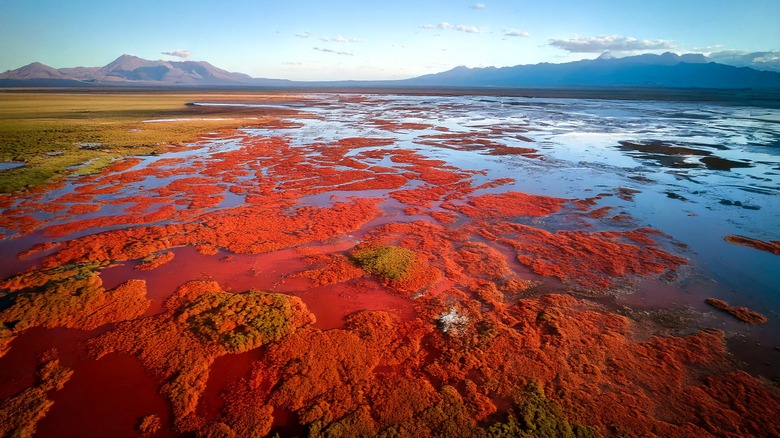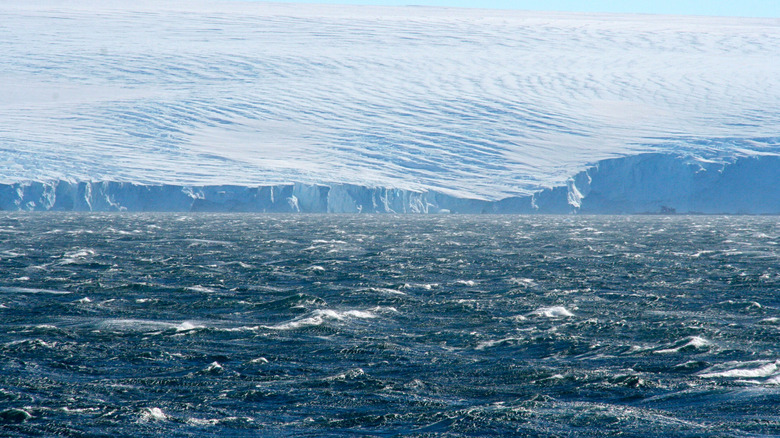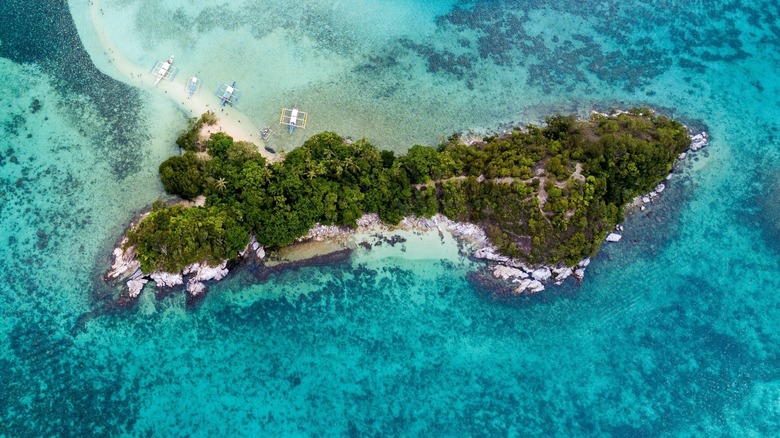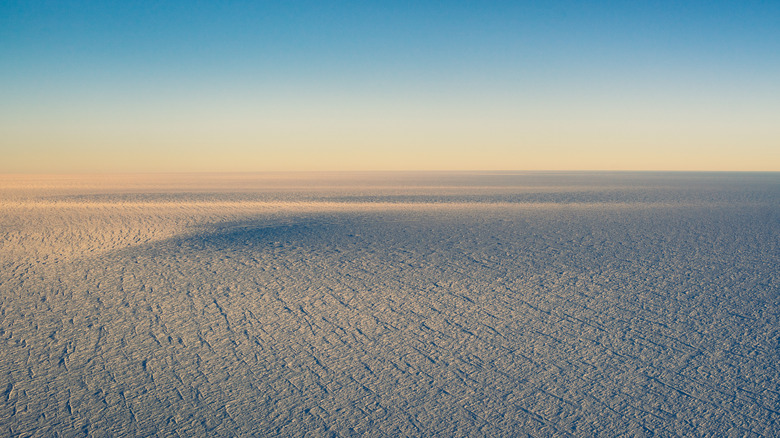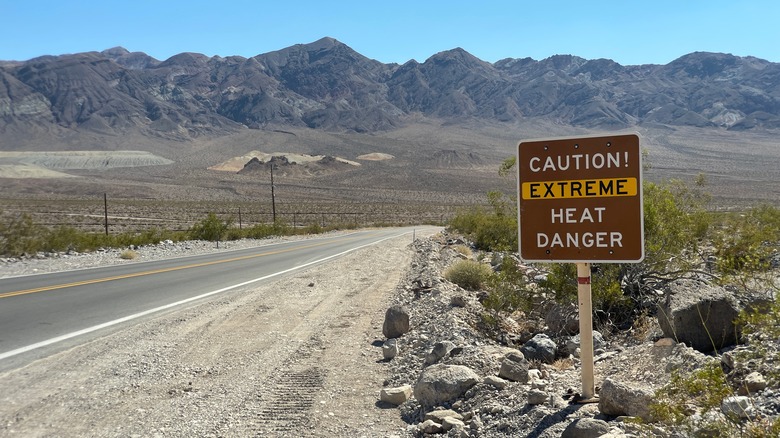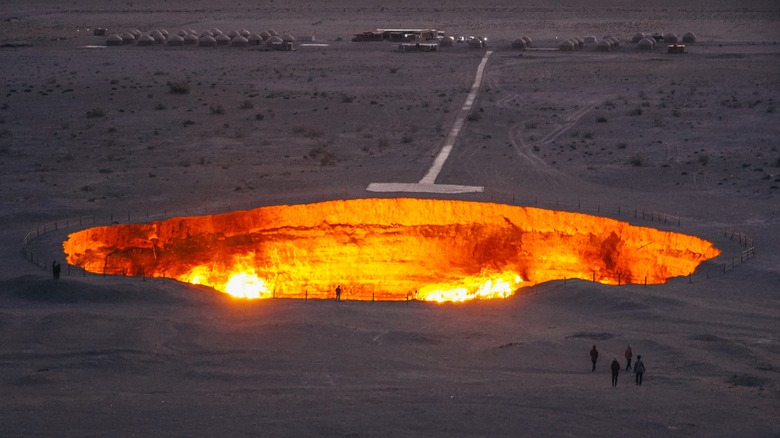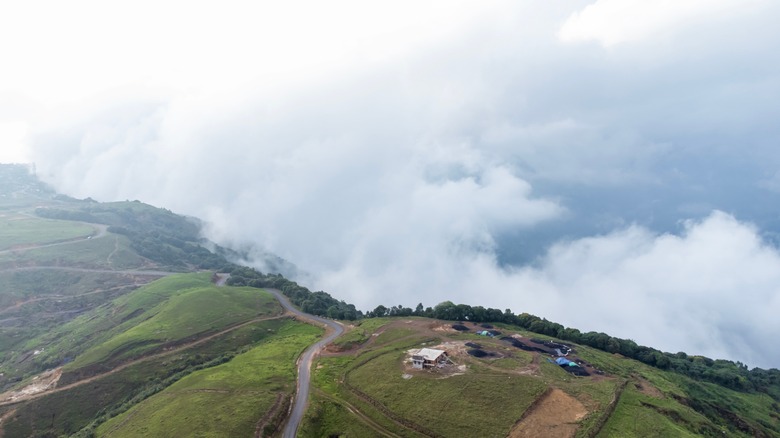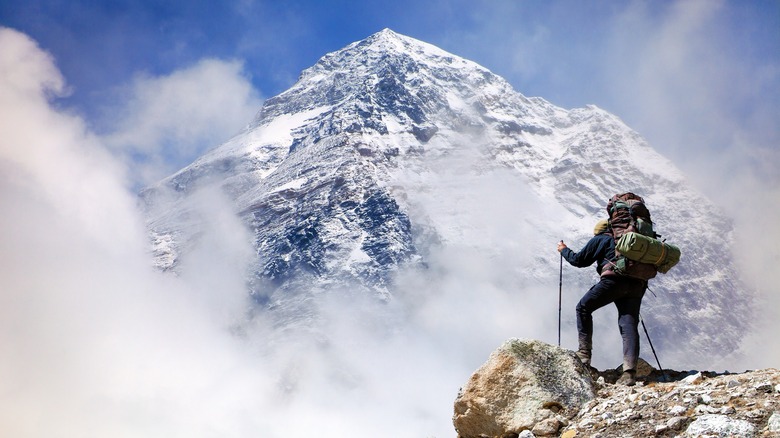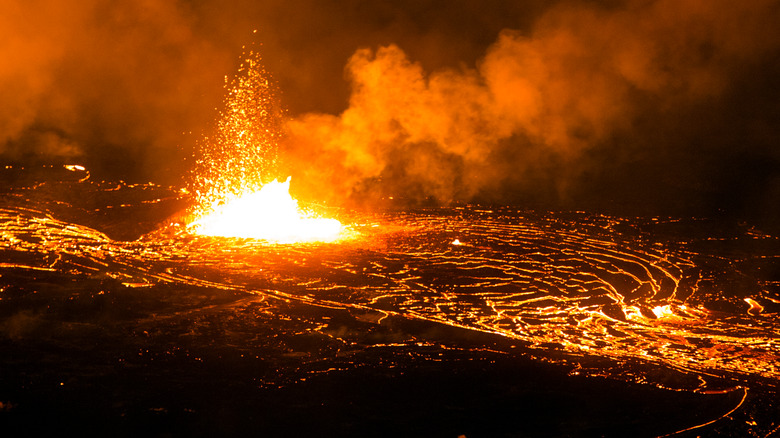11 Most Hostile Environments To Exist On Earth Today
Many people keep a bucket list of places they would like to visit one day. More often than not, it consists of a series of amazing locations with pleasing weather, sandy beaches, and pleasant sights to see. However, planet Earth is a big place, and it also contains plenty of spots that rarely make it to the traveling itinenaries of anyone but the most extreme-minded travelers.
There are areas in the world that seem custom designed to make life as uncomfortable or even unsurvivable for humanity as possible. With fire, ice, poison, extreme weather conditions, or just sheer inhospitability, these locations may be stunning to look at, but to say that they're not exactly friendly to human life is an understatement. Sure, if you really feel like it, some of the places on this list can be visited with adequate precautions, and people even live in others. However, there's no question that the following locations are some of the most hostile environments to exist in the world today.
Bouvet Island
If you're in the market for a vacation spot where there's absolutely no risk of bumping into huge tourist crowds, Bouvet Island is as remote as it gets. Unfortunately, it's also borderline impossible to reach, so don't expect any gift stops or picturesque street food stalls.
Located roughly 1,000 miles north from Antarctica and 1,500 miles south from Africa's southernmost tip, Bouvet Island is easily the most remote tiny piece of land in the world. Even if you like solace enough for that to sound like a paradise, there are a few further caveats, such as the small issue of it being borderline impossible to land on. Instead of fine, sandy beaches, Bouvet Island welcomes visitors with steep cliffs and a harsh terrain made of volcanic rock ... all covered with plenty of unforgiving ice, of course.
To illustrate just how little anyone wants to do with Bouvet Island, the area is considered Norway's territory despite a cool 7,900 mile distance between the island and the Nordic country. Technically, both France and Germany had claimed the island well before Norwegians did in 1927, but demand for the area was so low that Norway got to keep it. Perhaps understandably, the country doesn't exactly have mighty development plans for the 23-square-mile island. Instead, Norway has been happy to declare Bouvet Island a nature reserve and be done with it.
The Danakil Depression
As anyone who has seen a poisonous tropical frog (or even these two venomous frogs) can attest, dangerous animals can be quite colorful and pretty. As the Danakil Depression in Ethiopia proves, the same very much applies to geography. The area is extremely hot, and high tectonic and volcanic activity in the area has left it with a series of interesting and hostile natural phenomena. In this relatively compact area, you can see sights that range from salt flats to vibrantly colorful sulphur hot springs, where the water may be borderline boiling, extremely salty, and have a pH of 0.2 — making it more acidic than battery acid.
While the eerie beauty of the region makes it a popular tourist destination, the terrain is unstable and can be tricky to navigate. Even the air isn't entirely safe, thanks to poisonous gases and dangerous amounts of carbon dioxide that leave some areas littered with dead animals. As icing on the death cake, there's also an active volcano with an impressive lava lake. The area can also sometimes be dangerous to travel since it's located near the occasionally unruly border of Ethiopia and Eritrea, but that's not on the Danakil Depression.
The region is so hostile to life that only some microbes can survive there. However, some scientists have an affinity for the eye-popping area since it's the closest thing Earth has to offer for simulating alien landscapes. The depression's extreme conditions have even been compared to living inside nuclear waste.
Lake Natron
Speaking of vibrant colors, Tanzania's own Lake Natron can come across as one of the most Instagrammable resort areas out there. Despite this, it's a very bad idea to wade into these waters. Lake Natron, you see, is a huge, salty soda lake with a pH that's around 12, which makes its waters so deeply alkaline that they can cause serious damage to a human body.
"On the flats, you're presented with this intensely hot mud," biologist and documentarist David Attenborough's cameraman Matt Aeberhard described the rarely-visited Lake Natron to The Guardian. "The only way of walking around is with snowshoes on, to provide you with some sort of ability to trot across the mud, which can burn your legs and cause suppurating wounds that take ages to heal."
Apart from its extreme alkalinity, Lake Natron is also uncomfortably hot, with water temperature reaching 140 degrees Fahrenheit. Because of all this, most animals understandably avoid Lake Natron. However, lesser flamingos can withstand both alkaline and uncomfortably hot water, and they have adopted the predator-free area as their own. Lake Natron is eerily impressive on its own, and when you add massive, pink flamingo flocks and the looming Ol Doinyo Lengai volcano to the equation, the area's beauty more than matches its dangers.
Commonwealth Bay
If you see nice pictures of Antarctica's Commonwealth Bay and somehow manage to make travel arrangements to the region, you may find yourself wishing that you'd looked at a few video clips instead of still images ... or at least paid attention to the weather report. Commonwealth Bay might be a beautiful location for a fan of wintery landscapes, but it also happens to hold the Guinness World Record for the fastest recorded katabatic wind in history, which was measured in 1912. For reference, katabatic winds are essentially avalanches made of air — a huge air mass that gravity forces down along the terrain when it cools down and it density increases. This particular one reached the speed of 168 miles per hour — rmore than twice the Beauford scale's maximum wind speed of 72 to 83 mph, and the equivalent of a category five hurricane on the Saffir-Simpson hurricane scale.
Even animals who are generally accustomed to harsh Antarctic conditions aren't always safe in the Commonwealth Bay area. In 2010, a massive iceberg blocked the bay's entrance and stranded a 160,000-strong penguin colony. As of 2016, the colony was down to just 10,000 birds. Despite the fact that even penguins find the area challenging, Australians — who aren't exactly unaccustomed to extreme environments — set up shop in the area in 1912, and maintained the Australasian Antarctic Expedition's headquarters at the bay's Cape Denison area for two years. Hey, someone had to be there to experience that record katabatic wind.
Ilha da Queimada Grande
Even if you like snakes, it's probably a good idea to steer clear of Brazil's very own Ilha da Queimada Grande. If you hate poisonous and nonpoisonous snakes, on the other hand, there's an excellent possibility that this island is your absolute worst nightmare.
Colloquially known as Snake Island, Ilha da Queimada Grande is a small, densely-forested Atlantic island 21 miles off the coast of Brazil. Unfortunately, it's far from the paradise it seems to be, thanks to a large population of golden lancehead vipers who call the island their home. Just the fact that up to 4,000 of these snakes lurk on the 106-acre island is unpleasant enough, but golden lanceheads also happen to be around 2 feet long and extremely venomous. For understandable reasons, the snakes don't have a ton of prey on the island, so they've specialized in biting passing birds to bring them down ... and because this sort of feeding method requires considerable killing power, their venom is very, very strong. Should a human get bitten by just one of the island's slithery residents, a vast array of nasty symptoms from tissue death to renal failure may be on the menu.
From 1909 to the 1920s, a handful of brave souls actually did stay on the island before the lighthouse located there was automated. However, these days, Ilha da Queimada Grande is closed to the public. Only the Brazilian navy and scientists who study the medicinal properties of the snakes' venom are allowed entrance.
East Antarctic Plateau
Extreme temperatures are one of the best ways to tell that a given area is not necessarily optimal for a human presence. As such, it's only natural for the absolute coldest place on Earth to make an appearance on this list. This dubious honor goes to the East Antarctic Plateau, where surface temperatures can reach a literally cool -144.4 degrees Fahrenheit. This means that even if the Antarctic's usual native animals like penguins could comfortably reach this gigantic, Australia-sized inland area, they would have no chance of surviving there.
A region's ability to get this ridiculously cold is actually trickier than it seems, because it requires both extremely dry air and a prolonged darkness. The East Antarctic Plateau happens to have both, since its close enough to the South Pole to be subject to periods of sunlight-free polar night. Together with a long enough dry period, this enabled the area's record-breaking cold temperature. The East Antarctic Plateau might hold the record for a good while, too, seeing as the scientists who measured it in a study published in 2018 suspect that -144.4 degrees Fahrenheit is just about as cold as any place on Earth can naturally be.
Death Valley
It says a lot about humanity that Death Valley as we know it exists. California is home to the hottest place on Earth, and we clearly know this because it's literally called "Death Valley." Yet, none of this has stopped the area from becoming a fun national park for people to visit.
Death Valley's temperatures routinely exceed 120 degrees Fahrenheit during the summer, and it also has the highest recorded air temperature in the entire world – 134 degrees Fahrenheit. As such, stranded or unwary travelers can easily find themselves in mortal heat danger, and if this happens in a location that's too difficult for cars to reach, good luck waiting for a speedy rescue — the profoundly hot air is so thin that it prevents rescue helicopters from flying. As such, heatstroke deaths can and do happen fairly regularly in the area, especially since the condition can be difficult to recognize until it becomes critical.
A natural heat trap that's situated below sea level and surrounded by mountains on all fronts, Death Valley is indeed very hot ... but there is more to its dangers than mere high temperatures. The area is extremely dry, and on the rare instances that rain actually does occur, Death Valley's assorted crevices and canyons are prone to nasty flash floods. If that wasn't enough, the area also has many abandoned mines, and entering the crumbling tunnels is highly discouraged because they hold all manners of nasty surprises, including pockets of poison gas.
Darvaza gas crater
If you're in the market for a piece of real estate where a human being absolutely cannot survive, look no further than the Darvaza gas crater, aka the Gates of Hell. Of course, despite its resemblance to the Biblical depiction of hell, this pit is simply a huge hole full of burning gas, though this doesn't make it any less impressive or unnerving to look at.
The origin story of the Darvaza gas crater is something of a mystery, and could date all the way back to the 1960s. However, many sources date its origin to 1971, when Turkmenistan was a constituent of the Soviet Union. According to this story, a Soviet expedition to drill natural gas in the Karakum Desert created a huge, accidental crater which released gases in the air. Who exactly lit the Gates of Hell on fire and when is a matter of some dispute. Some say that the Soviets deliberately did it with a hand grenade or a simple match in a less than informed effort to quickly burn out the gas. Other narratives suggest that the burn-out attempt came courtesy of local residents who got tired of the smell.
Either way, the crater is still burning, and it has become something of a tourist destination for gawkers who wish to witness it in person. In 2013, one brave researcher even donned a heat-resistant suit and descended in the crater to collect samples of bacteria and other tiny organisms that braved the crater's conditions.
Mawsynram
The idea of "too much of something" is a classic recipe for disaster, and Mawsynram, India, proves this by having rain like you wouldn't believe. An otherwise unassuming village in the Khasi Hills region, Mawsynram holds the distinction of being the rainiest place on Earth with its over 470 inches of annual rainfall. For comparison, the notoriously rainy London gets about 23 inches of rain. What's more, these wet periods aren't spread evenly over the years. The majority of Mawsynram's rain comes between April and October, when the area "enjoys" its monsoon season. During this period, a single day could shower Mawsynram with nearly 40 inches of rainfall.
As you might expect, such heavy downpours can be one of the causes of flooding and landslides. The people of the area also need to find solutions to a whole host of less physically dangerous — but nevertheless impactful — rain-themed problems.They wear a type of hand-made full-body bamboo rain shield known as knup during the heaviest rainfall, and they proof their houses to minimize the sound of rain.
Still, despite all of these precautions, Mawsynram's rains can get so bad that sometimes the only viable defense is to stay indoors. "During the time of heavy rainfall it is impossible to go outside," local resident Jyotiprasad Oza told the Mirror in 2024. "We can't do our daily walk. We are not supposed to go outside during the rainy time. Sometimes children can't go to school during the rain. It is quite dangerous."
Mount Everest
Mount Everest is likely the most famous place on this list, and the dangers of the highest place on Earth are comparatively well-documented. That doesn't make them any less impressive, though.
According to latest measurements, Everest's peak stands roughly 29,032 feet above sea level, and the climb from the Everest Base Camp at 17,598 feet to the summit is full of dangers even during this era of comparative mass tourism. At 26,000 feet, the air gets extremely thin, and the temperatures plummet. Apart from succumbing to the elements, falling, or otherwise injuring themselves during the ascent, climbers also risk heavy winds, deadly avalanches, and a nasty oxygen deprivation condition called high-altitude cerebral edema, which swells up the brain, causes hallucinations, and severely impairs mental functions.
As of 2024, Nepal introduced a series of new responsibility rules that aim to improve mountaineering in the area, as well as protect Everest itself from overcrowding and trash buildup. However, the mountain itself can never be truly safe. Over 300 people have died on the trek — giving Mount Everest a rather high death toll — and many of them are still there, since removing bodies from the treacherous mountain can be borderline impossible.
Kilauea
No list of hostile places is complete without a volcano, but Kilauea is more than just your average dangerous, lava-spewing mountain. Located in Hawaii, this particular 4,090-foot mountain is the most active volcanic area in the world. It's even known for being the Hawaiian volcano that's barely stopped erupting since 1983. In the middle of it is a 500-foot deep caldera that's some 2 miles wide and 3 miles long, and periodically fills with lava. The caldera contains an inner crater called Halema'uma'u, which erupts so often that it's effectively a constant lake of lava — sometimes smaller, and sometimes huge enough to boil over into the larger caldera area. With its nigh-constant activity and respectable — though young by volcano standards — age of 280,000 years, Kilauea understandably has a place in Hawaiian mythology. Namely, the volcano goddess Pele is said to live inside Halema'uma'u.
Kilauea's usual volcanic activity is of the bubbling variety which can make it seem deceptively peaceful, but the popular tourist attraction is actually the deadliest volcano in the history of the United States by far. It and other nearby volcanic formations have erupted explosively several times, and the dangers the area poses can be quite surprising and stealthy. Kilauea has caused earthquakes, tsunamis, and destructive 88-day lava eruptions over the years, and in 1790, many members of a passing army unit died a grim death when they were hit by an unexpected steam explosion.
